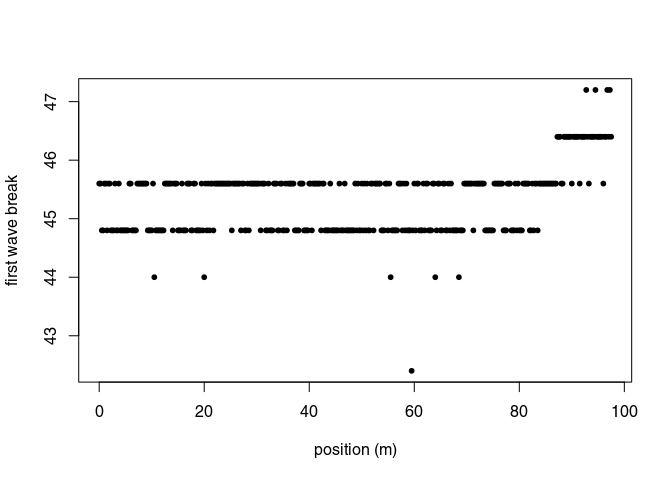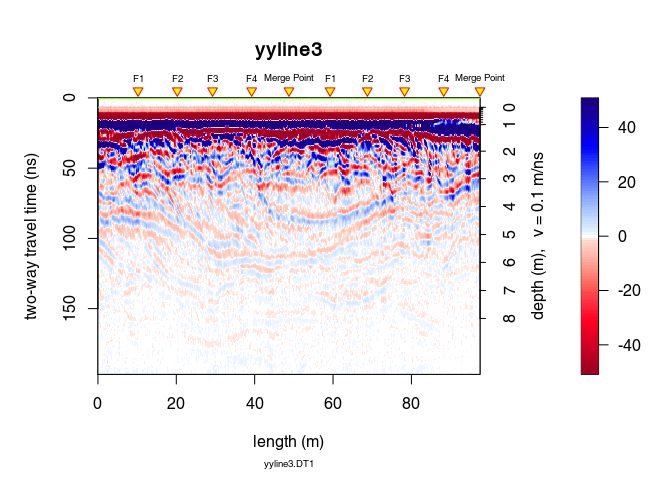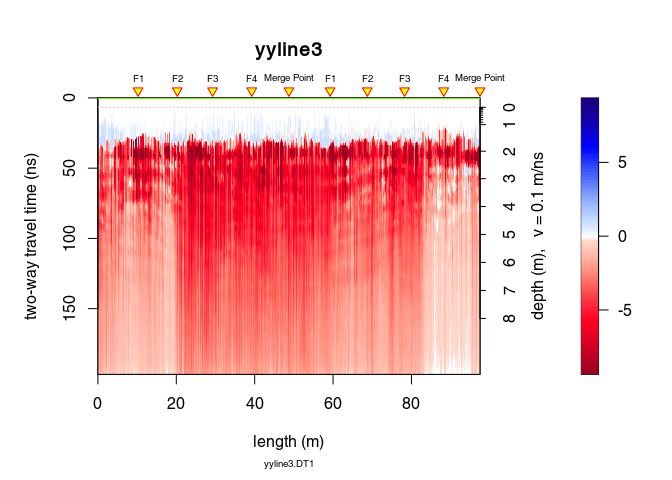Note:
Note that his tutorial will not explain you the math/algorithms behind the different processing methods.
We follow the approach proposed by Schmelzbach and Huber (2015), Efficient Deconvolution of Ground-Penetrating Radar Data, IEEE Transactions on Geosciences and Remote Sensing 53 (9), 5209-5217, doi:10.1109/TGRS.2015.2419235.
RGPRInstall/load RGPR
# install "devtools" if not already done
if(!require("devtools")) install.packages("devtools")
devtools::install_github("emanuelhuber/RGPR")
library(RGPR) # load RGPR in the current R session
Set the working directory:
DIR <- "~/2012_10_06_cornino" # adapt that to your directory structure
setwd(DIR) # set the working directory
getwd() # Return the current working directory (just to check)
x <- readGPR(dsn = "yyline3.DT1")
x <- x[1:300, ]
Quantify first wave break:
tfb <- firstBreak(x, w = 20, method = "coppens", thr = 0.05)
plot(pos(x), tfb, pch = 20, ylab = "first wave break",
xlab = "position (m)")

Convert first wave break to time-zero and set time-zero
t0 <- firstBreakToTime0(tfb, x)
time0(x) <- mean(t0) # set time0
x1 <- dcshift(x)
To shift the traces to time-zero, use the function time0Cor (the method argument defines the type of interpolation method)
x2 <- time0Cor(x1, method = "pchip")
Remove the low-frequency components (the so-called “wow”) of the GPR record:
x3 <- dewow(x2, type = "runmed", w = 50) # dewowing:
plot(x3) # plot the result

plot(x3 - x2) # plot the difference

To remove low (dewow) and high (noise) frequency (large bandpass to minimise the introduction of artifact)
x4 <- fFilter(x3, f = c(5, 20, 300, 400), type = "bandpass",
plotSpec = TRUE)

Apply a power gain and a spherical gain to compensate for geometric wave spreading and attenuation (Kruse and Jol, 2003; Grimm et al., 2006).
# power gain (compensate geometric spreading)
x5 <- gain(x4, type ="power", alpha = 1, t0 = 0, te = 200)
# exponential gain (compensate for attenuation)
x6 <- gain(x5, type ="exp", alpha = 0.023, t0 = 30, te = 180)
trPlot(traceStat(envelope(x4)), col = "red", main="")
trPlot(traceStat(envelope(x5)), col = "blue", add=TRUE)
trPlot(traceStat(envelope(x6)), col = "green", add=TRUE)
legend("topright",legend=c("before","power gain", "exponential gain"),
lwd=c(1,1,1), col=c("red","blue","green"))

Select the time window on which the deconvolution will be applied:
tWin <- c(32, 112) # ns
W <- which(depth(x6) > tWin[1] & depth(x6) < tWin[2])
plot(x6[W, ], main = "selected time window")

Apply the mixed-phase deconvolution: spiking deconvolution + phase rotation that maximise the kurtosis of the GPR data.
x_dec <- deconv(x6, method="mixed-phase", W = tWin, wtr = 5, nf = 35,
mu = 0.00001)

Estimated phase rotation: 103.13°.
The function deconv() (when method = "mixed-phase") returns a list of following elements:
fmin: estimated inverse minimum-phase waveletwmin: estimated minimum-phase waveletoptRot: rotation of the minimum-phase wavelet that maximise the kurtosiswmix: estimated mixed-phase wavelet (the rotated minimum-phase wavelet)x: the deconvolued dataYou can compare the results with the “minimum-phase deconvolution” also called “spiking deconvolution” by setting in deconv() method = "spiking" (in this case, deconv() returns only fmin, wmin and x).
In black the estimated wavelets for each trace, in red the mean wavelet.
w_min <- x_dec$wmin
w_mix <- x_dec$wmix
par(mfrow=c(1,2))
plot(0,0,type="n",xlim=range(w_min$x), ylim = max(abs(w_mix$y))*c(-1,1),
xaxs = "i", xlab = "time (ns)", ylab = "amplitude",
main = "minimum-phase wavelet")
grid()
apply(w_min$y,2,lines, x = w_min$x, col=rgb(0.2,0.2,0.2,0.2))
lines(w_min$x, apply(w_min$y,1,mean), col="red", lwd=3)
plot(0,0,type="n",xlim=range(w_mix$x),ylim=max(abs(w_mix$y))*c(-1,1),
xaxs = "i", xlab = "time (ns)", ylab = "amplitude",
main = "mixed-phase wavelet")
grid()
apply(w_mix$y,2,lines, x = w_mix$x, col=rgb(0.2,0.2,0.2,0.2))
lines(w_mix$x, apply(w_mix$y,1,mean), col="red", lwd=3)

To remove the high-frequency noise boosted by the deconvolution
x7 <- fFilter(x_dec$x, f = c(5, 20, 160, 210), type = "bandpass",
plot = TRUE)

x8 <- traceScaling(x7, type="stat")
plot(x6, main = "before deconvolution", clip = 30)

plot(x8, main = "after deconvolution", clip = 2)
